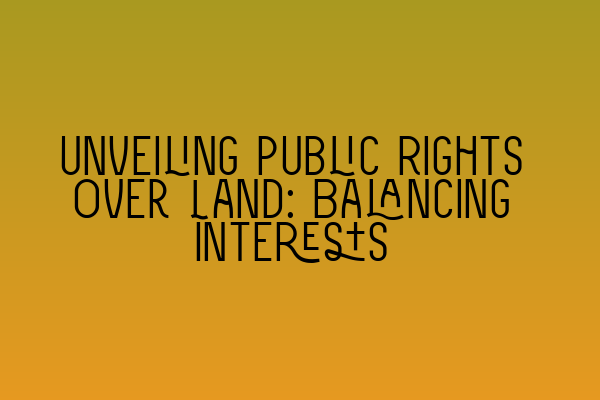Unveiling Public Rights Over Land: Balancing Interests
In the world of property law, the concept of public rights over land often comes into play. These rights, which are granted to the general public, can have a significant impact on both landowners and the wider community. Balancing these interests is crucial to ensure a fair and harmonious coexistence.
Public rights over land can take various forms, including rights of way, easements, and public access rights. These rights are typically established through legislation or legal precedent and serve to uphold principles of public interest and community welfare.
However, the existence of public rights over land can sometimes conflict with the rights and interests of individual property owners. This tension often arises when a landowner wishes to exercise full control over their land, but public rights restrict their actions or limit their use of the property.
To strike a balance between these competing interests, the legal system must consider several factors. These include the historical context, the purpose and nature of the public rights, and the potential impact on the landowner.
Historical Context:
Understanding the historical context is crucial when unraveling the nature and extent of public rights over land. Many public rights are rooted in long-standing traditions and customs, which have evolved over time. By delving into the historical background, it becomes easier to appreciate the significance and justification for the existence of these rights.
Purpose and Nature of Public Rights:
Public rights over land are established to serve specific purposes that benefit the greater community. For example, a public right of way allows people to traverse privately owned land to access public spaces, such as parks or beaches. These rights are intended to facilitate the enjoyment of public resources and promote social inclusion.
When examining public rights, it’s essential to consider their nature and purpose. This assessment helps determine the scope of the rights and the limitations they impose on landowners. Striking a balance between the needs of the public and the rights of landowners ensures a fair distribution of resources and protects the public interest.
Impact on the Landowner:
Public rights over land can have a significant impact on the landowner’s rights and interests. Restricting the use of land or granting access to the public can affect the landowner’s ability to develop the property or use it for their personal enjoyment. Therefore, it is crucial to assess the impact of public rights on the landowner and consider appropriate measures to mitigate any adverse effects.
One common approach to balancing interests is by implementing reasonable restrictions and regulations on public rights. For instance, landowners may be allowed to temporarily close access routes for maintenance or if there are exceptional circumstances. By allowing flexibility within the framework of public rights, the law strives to strike a fair balance between the interests of the public and the landowner.
Additionally, the legal system recognizes the right of landowners to protect their property from any misuse or abuse that may arise due to public access rights. Protective mechanisms, such as gating orders or permits, can be put in place to safeguard the landowner’s privacy and security while ensuring public access is maintained.
Finding the right balance between public rights and private property interests is an ongoing challenge for property law. It requires a delicate examination of historical context, the purpose of public rights, and the impact on the landowner. Through careful consideration and the implementation of reasonable regulations, the legal system can achieve a fair and reasonable balance that respects the rights of all parties involved.
To prepare for the SQE exams and gain a deeper understanding of property law and land law, SQE Property Law & Land Law offers comprehensive preparation courses. These courses cover various topics, including those related to public rights over land. With SQE 1 Practice Exam Questions and SQE 1 Practice Mocks FLK1 FLK2, students can test their knowledge and enhance their problem-solving skills.
For aspiring solicitors, SQE 2 Preparation Courses provide a comprehensive overview of property law and land law. These courses offer invaluable guidance and insights to excel in the SQE exams and in future professional practice.
Stay up-to-date with the latest SRA SQE Exam Dates to plan your study schedule effectively and ensure you have ample time to prepare for these important examinations.
In the complex landscape of property law, understanding public rights over land is essential. By striking a balance between the interests of the public and the rights of landowners, the legal system ensures fairness, equity, and the preservation of the greater social good.
